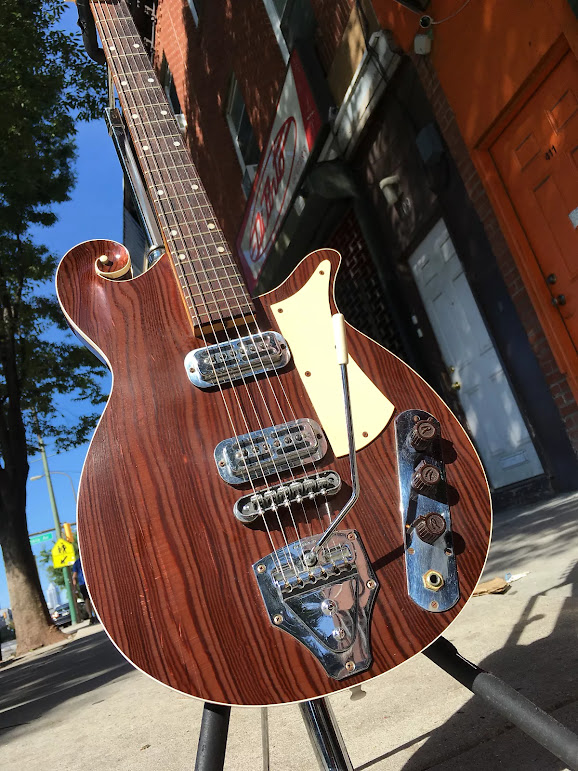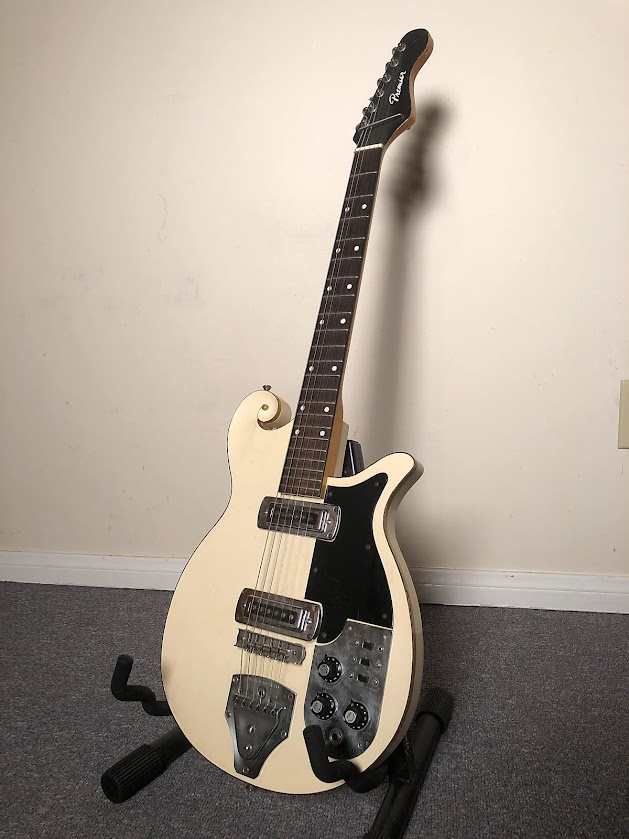Scroll guitars
1st Generation Set-neck - Symmetrical cutaway (1957/1958?)
Serial numbers known (2236)
This is the earliest serial number (2236) I have for a scroll guitar and the only symmetrical cutaway that I have seen. This is likely the earliest version (if there is anything before this I would expect it to either have Dearmond 210s, plastic Fransch pickups and/or a double cutaway with no scroll).
I don't know how far into the production run this one was made, but as the first serial number I have for the 2nd body style is only 33 away, I would be surprised if there were more than 50 produced. There are no more than 100 of the next style (and very likely half that), so one batch (12-24?) is likely.
2nd Generation Set-neck - Deep cutaway (1958?)
Serial numbers known (2269, 2270, 2278)
This is the 1st serial number (2269) I have for the 2nd body style (the pickup has been changed for a modern bigsby repro and a ground wire added). It is the only serial number I have sequentially and 2270 is the same configuration, which may suggest they were built in batches.
1st Generation bolt on neck - Short Horn / Disc Logo (1958/1959)
Serial numbers known (2353, 2394, 2413, 2497)
This is 1st serial number I have for a bolt on neck (2353) is 83 away from the nearest set neck. The scroll guitars were apparently first cataloged in 1959 (i haven't seen the 1958 catalog). The above is 2394. The catalog guitars have a stair stepped tailpiece like Bantams, but I have never actually seen one on a disc logo guitar, and they also have a quite different scroll shape (the gap between the scroll and the body is much more marked than any of the others I have seen), so there are probably bolt ons with lower serial numbers than here.
The below guitar has been emailed to me (2353) and has some unusual features. The pickup is the same style Fransch as was used the Marvel guitars but in gold - which I otherwise haven't seen - and suggests it is factory (the shim under it was added by the owner). The knobs were used on Premier amps and the shape of the horn is shorter than later guitars (bridge and tuners have been changed). The back and sides are also natural while the face is black (others I have seen are black all over). This all suggests that this guitar is probably very close to the first bolt on serial numbers.
2nd Generation bolt on neck - Wave Cutaway / Disc Logo (1959?)
Serial numbers known(2553, 2566, 2577)
This is a short lived revision but quite significant as it marks when the wave cutaway is introduced. The three serial numbers that I have are for different specs (sunburst single pickup, red double pickup and black single pickup).
3nd Generation bolt on neck - Wave Cutaway / Inlaid Logo, String retainer(1959 - 1962?)
Serial numbers known (2725, 2772, 2791, 2962, 2995, 3003, 3291, 3440, 3456)
The next revision and probably the longest lasting version has the logo changed from a plastic disk to an inlay in the headstock.
There is possible a short lived version in between this and the next where
they went back to an attached plastic logo (this time a triangle). I
don't know when this fits in as I don't have a serial number, but as it has a double pickguard I'd guess
it's towards the end of the US made run.
4th Generation bolt on neck - Wave Cutaway / Metal Control plate(1962 - 1963)
Serial numbers known (3380)
The two serial numbers I have after the above both have slightly less common features - a Bigsby on the one Ry Cooder owns (3440) and triple pickups on 3456 - so it might be that those were using up older bodies on special orders, but with only a single serial number it's hard to say anything definitive.
5th Generation bolt on neck - Wave Cutaway / Metal Control plate / no binding(1963?)
Serial numbers known (3606)
A new variant that I had presumed was just the result of a lazy refinish is the 4th gen style but without any body binding. I now have photos of two of them (one just one photo without a serial number). The headstock also looks to have lost it's inlay (this is possibly where the triangle logo fits in) so presumably they were either trying to cut costs or using up leftover stock.
Update 2023:
This guitar (serial 3614) confirms that the triangle insert is a late feature.
Jr solidbody (1961-1962?)
Serial numbers known (3581)
The Jr was a simplified and short scale (23") student version. I have only seen two and both have single pickups (different tailpieces). I doubt many of these exist.
1st Generation Celluloid - Small metal plate (1964 - 1965?)
Serial numbers known (4511, 479*)
This period has the biggest changes and I have very limited examples from which to draw conclusions. There are approx. 1000 serial numbers between the above and the last Fransch equipped s/n I have (3581). There were apparently no solidbodies listed in the 1963 price list, so they may not have made any between 3600-4500ish (a few prototypes maybe) or maybe they skipped some numbers when they went off shore. As this one is using a string retainer (they changed to a steel retaining rod in this era) from an style earlier guitar, I think this is probably from right at the beginning of the celluloid era. The multivox plate is now a sticker, which may be another reason for them to skip some numbers.
Apparently some of these early guitars might've had bodies made in New York but this hasn't been proven. The main defining feature of these early celluloid guitars is the Dearmond model 55 pickups and the long control plate.
I imagine there are a number of guitars with unusual features from this era. The most likely thing I would expect to see a New York built body in ruby red with the same Dearmond model 55s.
2nd Generation Celluloid - large metal control plate (1964 - 1970?)
Serial numbers known (5641, 5655)
This one (5641) is from near the end (i'd guess about 1968). It still has a bit of Premier flairs (gold sparkle binding) and the double dot fretboard. The pickups I believe are made be Teisco.
Offset Body (1966?-1970?)
Serial numbers known (6158)
The offset body was offered from at least 1966 but possibly a bit earlier. This one is probably one of the last scroll guitars made around 1969-1970. By this point they seem to have stopped giving them serial numbers. The neck says Made in Holland which means it was made by Egmond (who Sorkin distributed in the US). Whether they made the whole thing or just the neck I don't know. The zero fret and dot pattern (and I suppose the adjustable truss rod) are signs of a Egmond made, late guitar.















I have 2353.
ReplyDeleteand it hasn't a scratch on body or binding
Bolt on
ReplyDeletehttps://photos.app.goo.gl/qEx3KcieZkbGqn1s5
ReplyDeletehttps://photos.app.goo.gl/bp8rQ7PiQcxoGfpz6
ReplyDeleteBakelite, but Not sparkly
ReplyDeletehttps://photos.app.goo.gl/KxceWRULEaWNCKJo7
July 22, 2020
ReplyDeletehttps://photos.app.goo.gl/SW8QvWej9FaudXXs8
Thank you for the photos! That is a fascinating guitar and important in the evolution. It has the smaller Fransch pickup like the Marvel guitars and Marvel knobs which are original features on a Premier that I haven't seen before. They were obviously experimenting a lot with the design around this time. if you could email me at premierguitarhistory@gmail.com with a picture of the whole guitar without the strap over it I'll add it into the above chronology.
DeleteI have been leaning towards: Someone when putting this guitar together, (which ha a shiny mahogany back and matte top, saw the deep brown and decided Those tone volumes would match this guitar best - in the light they are a deep oxblood somewhat translucent - I like 'em.
Deletethey are on some of the premier amps from that era
3380
ReplyDeletehttps://www.gbase.com/powered/rivington-guitars/gear/premier-custom-solidbody-scroll-guitar-1959-natural
This is Mark, who submitted info on scroll Premiers and one I own (serial number 2566) on the Guitarz site in 2012.
ReplyDeletehttp://guitarz.blogspot.com/2012/01/multivoxpremier-carved-scroll-mahogany.html
That guitar has what I consider to be the "wave" cutaway, with an outward curve. To distinguish most clearly between body shapes I might not use the term to describe the earlier long- and short-cutaway body shapes that don't have that specific "cresting" profile. Note that 2566 has both the cresting-wave profile cutaway and a neck with the earlier angled headstock and round badge logo; it's transitional between your 1st- and 2nd-generation bolt-on types, in other words. I also have a single-pickup, short-cutaway model like the 1st-generation bolt-on example you picture, but with original ebony bridge and plastic button tuners, serial number 2413. Thank you for putting this chronology together! I still gig and record with 2566. It plays great and sounds nice, and always gets a lot of comments.
Hi Mark,
ReplyDeleteGreat to hear from you! Yours is easily one of the nicest examples out there and I agree it's probably the pinnacle of the design. Thank you for sharing the serial number - it definitely helps to pin down when features first appeared.
You are absolutely right that I haven't taken enough care to deliniate between the short horn and the cresting wave cutaway so I will revise the above to reflect that, and put yours in as the first known bolt-on evolution. I think I need a new naming system as everything gets thrown off when new versions appears, and Premier seemed to change something about every batch.
I'm hoping more unusual ones will come out of the woodwork with time. When I first started looking for one I saw three hulks for sale all at the same time which gave me the false impression that they were common. I waited 3 years before another one I could buy came up, but I'd still like to know what the new owners did with those wrecked ones.
2605
ReplyDeletehttps://reverb.com/item/60694247-premier-e-727-1958-or-1959-red-w-gold-accents